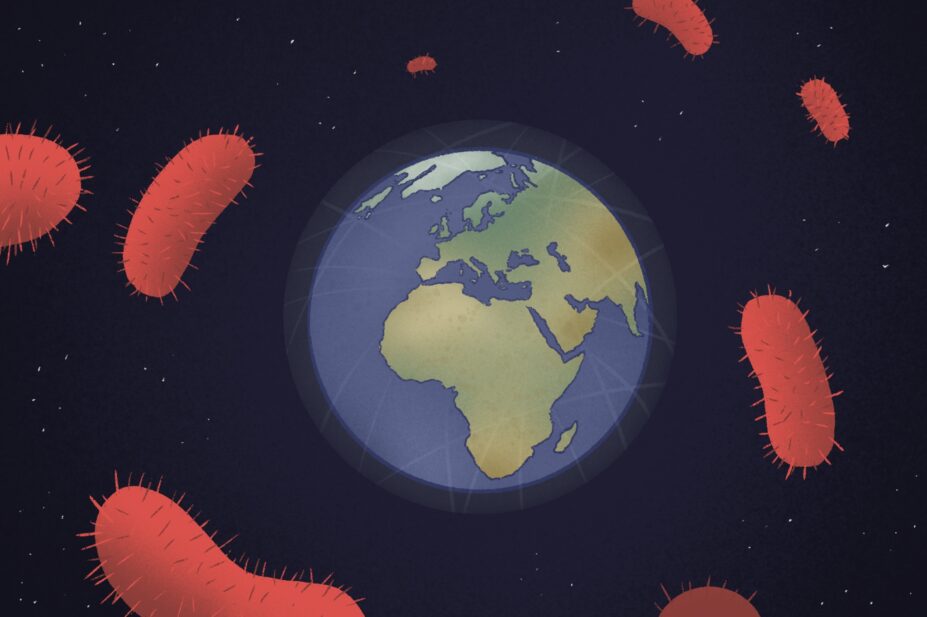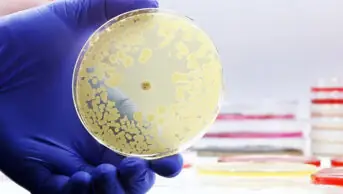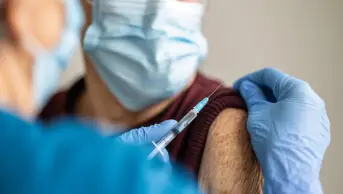
Wes Mountain/The Pharmaceutical Journal
Antimicrobial resistance (AMR) is recognised as one of the most significant global threats to public health. In 2021, it was estimated that there were 4.7 million deaths associated with bacterial AMR, and more than 1 million people died as a direct consequence of AMR1.
If no interventions are put in place to combat AMR at a global level, it is predicted that an estimated 8 million deaths associated with AMR could occur globally in 2050, alongside a significant impact on health systems and economies, with reduced options for treating infections, longer hospital admissions and difficulties supporting surgery and chemotherapy delivery1,2.
AMR is undoubtedly a multifactorial problem, exacerbated by the misuse of antibiotics in both humans and animals, in addition to agricultural and environmental components. Inappropriate antibiotic use in humans can occur through overprescribing, empirical treatment and unrestricted access to over-the-counter (OTC) antibiotics. Other contributing factors include a lack of clinical diagnostic tools in low-resource settings, access to quality-assured medicines, and awareness and education regarding AMR3.
Vital interventions that can form part of the action against AMR in human medicine include: the development and implementation of antimicrobial stewardship (AMS) and educational programmes; restrictions on prescribing; strengthened regulations on access to antibiotics without a prescription; and the facilitation of international collaboration and shared learning through global health partnerships.
Global health partnerships are a fantastic opportunity to learn from others, share ideas, develop sustainable strategies
However, addressing AMR necessitates a global effort with collaboration in line with the One Health approach, which involves different sectors, including human and veterinary medicine, agriculture, the public, environment and the financial industry4.
Global health partnerships, or the term ‘global health’, can often be perceived as consisting of relationships between a high-income country (HIC) and a low and middle-income country (LMIC) partner or work linked to LMICs. However, as described by Ashiru-Oredope et al. in 2023, global health partnerships include any collaborative partnership, transnational research or actions aimed at promoting health for all5.
Global health partnerships can also form a critical component in strengthening capacity and working towards development goals and global health targets through collaboration, shared agenda setting and mutually beneficial learning6. What is essential in effective global health partnerships is creating solutions together to ensure sustainable change.
Partnership in Zambia
Although a global challenge, inequalities do exist. The effects of AMR are even more significant in LMICs, owing to the higher infectious burden in these countries, compounded by resource and infrastructure constraints in addressing the challenge7. Data published in 2024 suggest that the highest rates of AMR burden are in sub-Saharan Africa and South Asia1.
There is a need for improved education and training programmes across LMICs, with studies demonstrating an educational gap in knowledge and attitudes to AMR among healthcare professionals. A survey of 340 healthcare professionals working in hospitals across 58 different LMICs revealed that issuing guidelines and education were the two most effective AMS interventions8.
These principles have been put into practice at Ndola Teaching Hospital (NTH) in Zambia, through a global health partnership facilitated by King’s Global Health Partnerships (KGHP). NTH is in line with the Commonwealth Partnerships for Antimicrobial Stewardship (CwPAMS) programme, a health partnership programme funded by the UK aid programme Fleming Fund and managed by the Commonwealth Pharmacists Association and Global Health Partnerships (formerly the Tropical Health Education Trust).
The partnership has supported the work of the AMS committee at NTH, with additional collaboration provided by UK-based pharmacists and a microbiology registrar. UK volunteers have primarily supported the following three workstreams through a combination of remote support and in-country visits to NTH. A UK observership was also hosted, whereby a physician and pharmacist from NTH were able to spend two weeks observing processes and practice within an NHS trust.
Workstream 1: Establishing a ‘Pharmacy Champion’ education programme
The delivery of the AMS champion training programme has consisted of bi-weekly sessions for ten pharmacists from NTH and two pharmacists from Arthur Davison Children’s Hospital. The champions also presented case study examples that they have encountered in their own clinical practice. Additionally, weekly AMS ward rounds take place to ensure that champions can put their theoretical knowledge into practice.
The approach to this project was influenced by the success of the AMS ‘Pharmacy Champions’ programme in Sierra Leone, which was implemented by KGHP and Connaught Hospital during a previous CwPAMS programme. Evidence from that project showed how focusing on delivering a quality blended learning programme for a concentrated small group could have a substantial impact on knowledge, skills, attitude and practice.
It is proposed by the partnership that by training a critical mass of AMS ‘Pharmacy Champions’ at NTH, they will have a network of peers and informed leaders who will support the implementation of AMS interventions beyond the project, cascade their training to others, support community engagement and ensure continued education and behaviour change.
Workstream 2: Developing hospital-level antimicrobial prescription guidelines
Guideline development can be hindered in LMICs by a lack of local evidence. However, by partnering with the Fleming Fund laboratory to use their local data, it is anticipated that the upcoming guideline that is planned to be disseminated at NTH will have a valuable role in promoting rational antibiotic prescribing, while also ensuring local expertise for future versions as more data are acquired8.
Workstream 3: Researching the effectiveness of NTH drug charts
A proposal was developed and conducted to evaluate the impact of the drug charts on antibiotic prescribing practices at ward level using a mixed-methods approach. Prescribers’ perceptions on the drug charts were also explored and used to highlight potential improvements for future iterations of the drug chart.
Sharing knowledge
To see lasting improvement in AMR outcomes, a global commitment to the sharing of knowledge through international partnerships is crucial. To be effective, these partnerships must be undertaken with mutual respect, a shared vision and with consideration of the local and cultural context.
The mutually beneficial learning from this global health partnership between the UK and Zambia has shown benefits to me, as a UK volunteer, including improving my leadership and cultural awareness, as well as the building of valuable personal and professional connections. From the other perspective, the partnership has supported increased leadership capacity of the partner AMS committee and the development of tools, knowledge and behaviours to support ongoing change and AMS stewardship going forwards.
Global health partnerships are a fantastic opportunity to learn from others, share ideas, develop sustainable strategies in building a stronger health workforce and improve the quality of healthcare. However, time needs to be invested in building strong relationships, which was accelerated by the incorporation of in-country visits and UK observership.
As well as realising benefits to personal professional development through the course of the project, it has been incredibly rewarding to see the growth in knowledge and confidence of the AMS ‘Pharmacy Champions’ during our second trip to Ndola, having observed additional pharmacy-led AMS rounds and intervention documentation.
Pharmacy professionals have a crucial role to play, both in promotion of AMS on a local level, supporting the rational use of antibiotics, but also through the provision of leadership, education and expertise through international partnership working to influence outcomes on a broader scale.
Pharmacy professionals can also provide support to LMICs through mentorship roles, such as the CwPAMS Africa Leadership Fellowship-AMS programme, which provides opportunities for African fellows in furthering their leadership development by delivering AMS initiatives within their workplace.
If not tackled at a global level, AMR poses an immense threat. This is everyone’s problem — how are you going to help?
- 1.Naghavi M, Vollset SE, Ikuta KS, Swetschinski LR, Gray AP, Wool EE. Global burden of bacterial antimicrobial resistance 1990–2021: a systematic analysis with forecasts to 2050. The Lancet. September 28, 2024. https://www.thelancet.com/journals/lancet/article/PIIS0140-6736(24)01867-1/fulltext
- 2.O’Neill J. Tackling Drug-resistant Infections Globally: Final Report and Recommendations. Review on Antimicrobial Resistance. May 2016. https://amr-review.org/sites/default/files/160525_Final%20paper_with%20cover.pdf
- 3.Kakkar AK, Shafiq N, Singh G, Ray P, Gautam V, Agarwal R. Antimicrobial Stewardship Programs in Resource Constrained Environments: Understanding and Addressing the Need of the Systems. Frontiers in Public Health. April 28, 2020. https://pmc.ncbi.nlm.nih.gov/articles/PMC7198767/
- 4.Global action plan on antimicrobial resistance . World Health Organization. January 14, 2025. https://iris.who.int/bitstream/handle/10665/193736/9789241509763_eng.pdf
- 5.Ashiru-Oredope D, Langford BJ, Bonaconsa C, Nampoothiri V, Charani E, Goff DA. Global collaborations in antimicrobial stewardship: All hands on deck. Antimicrobial Stewardship & Healthcare Epidemiology. April 5, 2023. https://www.cambridge.org/core/journals/antimicrobial-stewardship-and-healthcare-epidemiology/article/global-collaborations-in-antimicrobial-stewardship-all-hands-on-deck/BB72C08DFCC67F453752A829DF652573
- 6.Global Catalyst Group for Institutional Health Partnerships: Position Statement. Global Health Partnerships. January 14, 2025. https://www.thet.org/wp-content/uploads/2017/08/global-catalyst-group-final.pdf
- 7.Bebell LM, Muiru AN. Antibiotic use and emerging resistance — how can resource-limited countries turn the tide? Global Heart. October 31, 2014. https://pmc.ncbi.nlm.nih.gov/articles/PMC4369554/
- 8.Cox J, Vlieghe E, Mendelson M, Wertheim H, Ndegwa L, Villegas M. Antibiotic stewardship in low- and middle-income countries: the same but different? Clinical Microbiology and Infection. November 23, 2017. https://pubmed.ncbi.nlm.nih.gov/28712667/
1 comment
You must be logged in to post a comment.



AMR in LMIC is greatly impacted by supply chain issues including shortages, the high percentage of counterfeit and substandard medicines and the affordability of quality products. The Global Health Partnerships are an excellent way of improving practice and learning about each others' challenges, though not all partnerships involve pharmacists. But solutions from the NHS where supply chains are secure and reliable do not always translate. We need to upskill ourselves and others on medicines' quality, regulation and secure supply chains, and advocating for appropriate levels of investment in quality medicines procurement and pharmacy staff development.